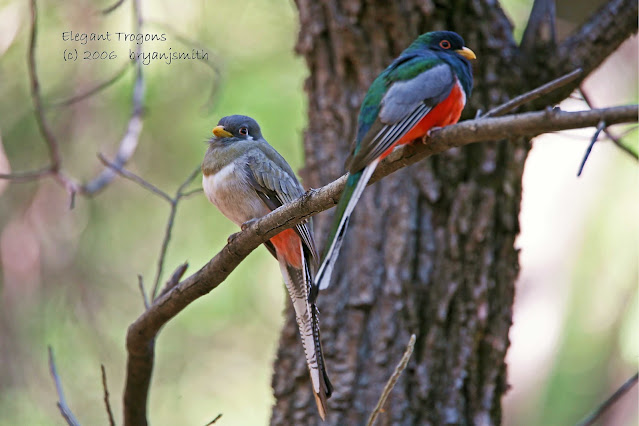TEN YEARS of ELEGANT TROGON SURVEYS in SOUTHEAST ARIZONA
By Jennie MacFarland

Elegant Trogon pair by bryanjsmith
The spring of 2022 marked the 10th year of Tucson Audubon coordinating Elegant Trogon surveys of five Sky Island mountain ranges of Southeast Arizona. With the help of 95 volunteers, 84 different routes were surveyed for trogons during the month of May. Each of the five mountain ranges surveyed is an Important Bird Area and surveyed on its own weekend day starting the second week of May. The Atascosa Highlands (Atascosa Mountains plus the Pajarito Mountains) are surveyed earliest as they are the lowest elevation of all five ranges. Heat is a particular concern in this area so we do it as early as possible. The Patagonia and Santa Rita Mountains are always the following weekend. The last weekend of the month, Memorial Day Weekend, is when the two largest ranges are surveyed, the Huachuca and Chiricahua Mountains.
 |
| Trogon habitat in the Chiricahua Mountains by Matt Griffiths |
The timing of these surveys is specifically chosen with careful input from Rick Taylor, who ran a survey of Elegant Trogons of the Chiricahua and sometimes Huachuca Mountains for many years before Tucson Audubon joined the effort and expanded the survey to five mountain ranges. By May in most years, nearly all of the Elegant Trogons that wintered in Mexico have returned to Arizona and the males are very vocal. Their territorial barks make them very easy to detect on the survey even when no playback is used. Most of the Elegant Trogon pairs are not quite at the nesting stage yet which minimizes the risk of our surveying disturbing active nests.
 |
| Trogon with prey by Jeremy Hayes |
Elegant Trogons usually have territories established by May but when they actually nest is highly variable. Some lay eggs as early as May but most egg laying starts in June and continues into July. This timing maximizes the chances that large insect abundance is peaking when nestlings need a lot of food and then need to learn to hunt as fledglings in late summer. Not only is the current monsoon a large part of trogon nesting success, but the rainfall of the previous year also plays a pivotal role. When Elegant Trogons first arrive in April, habitat conditions in the Sky Island mountain ranges are very influenced by the previous year’s levels of both monsoon and winter rains. Our lowest ever count of trogons occurred in 2021 with only 68 individuals. Ironically, the 2021 monsoon was one of the wettest on record but it followed a previous 12 months (June 2019–June 2020) that were some of the driest ever in Southeast Arizona. It was these drought conditions that Elegant Trogons moving north in 2021 encountered and resulted in the very low count. The habitat was so stressed that spring that many traveling trogons turned back toward parts of Mexico that had received more rain the previous year.
 |
| The "non-soon" of 2020 |
 |
| The rain rebound of 2021 |
.png) |
| Total trogons by mountain range over 10 years |
The 2022 results are very interesting as they have increased over 2021 (nearly double!) and show a population rebound occurring but still 80 short of the all time high of 201 in 2020. These fluctuations are so intriguing when compared to habitat conditions as influenced by monsoonal rainfall of the previous year. The University of Arizona maps show cumulative monsoon rainfall in comparison to average monsoon rainfall for each area. Within the maps, brown areas indicate areas that received below average rainfall from the monsoon that year, white indicates an average amount, green is above average and blue is about three times the average amount of rainfall. Elegant Trogons feed mostly on fruits and large bodied insects such as katydids and walking sticks. The availability of both of these food sources is strongly influenced by monsoon moisture in southern Arizona. It’s no wonder then that severely fluctuating rainfall over the past three years could lead to such differing results in the Elegant Trogon count over the same time period. If the trend continues after this very good 2022 monsoon season and the region gets normal rains over the winter, there’s no reason to suspect we won’t count even more trogons in 2023!
 |
| Male Elegant Trogon by Shawn Cooper |
Special thanks to the hundreds of volunteers who have made the last 10 years of the Elegant Trogon Survey of Southeast Arizona possible! It is the largest annual survey of the Arizona Important Bird Areas program and we couldn’t have done it without you! Thanks!
Jennie MacFarland is the Bird Conservation Biologist for Tucson Audubon.

Comments
Post a Comment
Thanks, we value your opinions! Your comment will be reviewed before being published.